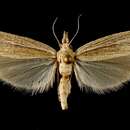Conservation Status
provided by University of Alberta Museums
Rare. Apparently restricted to sandy areas in SE Alberta.
- license
- cc-by-nc
- copyright
- University of Alberta Museums
Cyclicity
provided by University of Alberta Museums
July and August.
- license
- cc-by-nc
- copyright
- University of Alberta Museums
Distribution
provided by University of Alberta Museums
Type material from Aweme, Manitoba (McDunnough). Reported from dunes in Michigan (Scholtens, 1996). There is a specimen from the Pinery area in Ontario in the Canadian National Collection (CNC). Not mentioned for Alberta by Bowman (1951). Specimens collected by D. F. Hardwick on July 10, 1951 at Manyberries, and by E. E. Sterns on July 13, 1956, are in the Canadian National Collection. Collected on August 13, 2008 by Gary Anweiler from sand dunes, 70 km NE of Suffield, Alberta.
- license
- cc-by-nc
- copyright
- University of Alberta Museums
General Description
provided by University of Alberta Museums
A medium sized crambid with a wingspan of 22-25 mm. Members of the genus Loxocrambus can be recognized by having a roughly 45 degree-angled bulge in the end of the outer margin of the forewing. Back of this there are three black dots and a ST line which is close to and which parallels the terminus. Cubital vein from base to end of cell, white, with slight dark shading below. The related Loxocrambus coloradellus occurs farther south. It is somewhat smaller, wingspan 17-22 mm, and has a PM line which is lacking in awemensis, and an ST line which is farther back from the terminus of the forewing.
- license
- cc-by-nc
- copyright
- University of Alberta Museums
Habitat
provided by University of Alberta Museums
Sand dune areas.
- license
- cc-by-nc
- copyright
- University of Alberta Museums
Life Cycle
provided by University of Alberta Museums
Unknown.
- license
- cc-by-nc
- copyright
- University of Alberta Museums
Trophic Strategy
provided by University of Alberta Museums
George Balogh reared a specimen from a pupa in a sand tube near dune grasses at Saugatuck dunes, Michigan (Scholtens, 1996).
- license
- cc-by-nc
- copyright
- University of Alberta Museums
Loxocrambus awemensis
provided by wikipedia EN
Loxocrambus awemensis is a moth in the family Crambidae. It was described by James Halliday McDunnough in 1929.[1] It is found in North America, where it has been recorded from Manitoba, Alberta, Michigan and Ontario.[2] The habitat consists of sand dunes.
The wingspan is 22–25 mm. Adults are on wing in July and August.
Larvae have been reared from a pupa in a sand tube near dune grasses.[3]
References
-
^ Nuss, Matthias; Landry, Bernard; Vegliante, Francesca; Tränkner, Andreas; Mally, Richard; Hayden, James; Bauer, Franziska; Segerer, Andreas; Li, Houhun; Schouten, Rob; Solis, M. Alma; Trofimova, Tatiana; De Prins, Jurate & Speidel, Wolfgang (2003–2014). "GlobIZ search". Global Information System on Pyraloidea. Retrieved July 15, 2014.
-
^ "800885.00 – 5429 – Loxocrambus awemensis – McDunnough, 1929". North American Moth Photographers Group. Mississippi State University. Retrieved August 13, 2020.
-
^ Bird, C. D. (2009). "Species Details: Loxocrambus awemensis". University of Alberta Museums. E.H. Strickland Entomological Museum. Retrieved December 29, 2020.

- license
- cc-by-sa-3.0
- copyright
- Wikipedia authors and editors
Loxocrambus awemensis: Brief Summary
provided by wikipedia EN
Loxocrambus awemensis is a moth in the family Crambidae. It was described by James Halliday McDunnough in 1929. It is found in North America, where it has been recorded from Manitoba, Alberta, Michigan and Ontario. The habitat consists of sand dunes.
The wingspan is 22–25 mm. Adults are on wing in July and August.
Larvae have been reared from a pupa in a sand tube near dune grasses.
- license
- cc-by-sa-3.0
- copyright
- Wikipedia authors and editors

